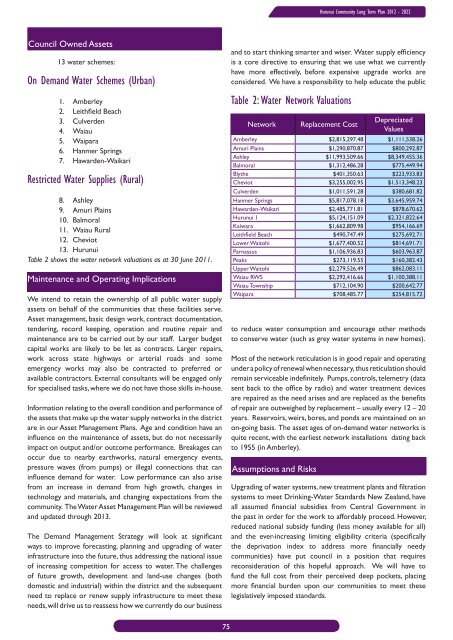Long Term Community Plan 2012-2022 - Hurunui District Council
Long Term Community Plan 2012-2022 - Hurunui District Council
Long Term Community Plan 2012-2022 - Hurunui District Council
You also want an ePaper? Increase the reach of your titles
YUMPU automatically turns print PDFs into web optimized ePapers that Google loves.
<strong>Hurunui</strong> <strong>Community</strong> <strong>Long</strong> <strong>Term</strong> <strong>Plan</strong> <strong>2012</strong> - <strong>2022</strong><br />
<strong>Council</strong> Owned Assets<br />
13 water schemes:<br />
On Demand Water Schemes (Urban)<br />
1. Amberley<br />
2. Leithfield Beach<br />
3. Culverden<br />
4. Waiau<br />
5. Waipara<br />
6. Hanmer Springs<br />
7. Hawarden-Waikari<br />
Restricted Water Supplies (Rural)<br />
8. Ashley<br />
9. Amuri Plains<br />
10. Balmoral<br />
11. Waiau Rural<br />
12. Cheviot<br />
13. <strong>Hurunui</strong><br />
Table 2 shows the water network valuations as at 30 June 2011.<br />
Maintenance and Operating Implications<br />
We intend to retain the ownership of all public water supply<br />
assets on behalf of the communities that these facilities serve.<br />
Asset management, basic design work, contract documentation,<br />
tendering, record keeping, operation and routine repair and<br />
maintenance are to be carried out by our staff. Larger budget<br />
capital works are likely to be let as contracts. Larger repairs,<br />
work across state highways or arterial roads and some<br />
emergency works may also be contracted to preferred or<br />
available contractors. External consultants will be engaged only<br />
for specialised tasks, where we do not have those skills in-house.<br />
Information relating to the overall condition and performance of<br />
the assets that make up the water supply networks in the district<br />
are in our Asset Management <strong>Plan</strong>s. Age and condition have an<br />
influence on the maintenance of assets, but do not necessarily<br />
impact on output and/or outcome performance. Breakages can<br />
occur due to nearby earthworks, natural emergency events,<br />
pressure waves (from pumps) or illegal connections that can<br />
influence demand for water. Low performance can also arise<br />
from an increase in demand from high growth, changes in<br />
technology and materials, and changing expectations from the<br />
community. The Water Asset Management <strong>Plan</strong> will be reviewed<br />
and updated through 2013.<br />
The Demand Management Strategy will look at significant<br />
ways to improve forecasting, planning and upgrading of water<br />
infrastructure into the future, thus addressing the national issue<br />
of increasing competition for access to water. The challenges<br />
of future growth, development and land-use changes (both<br />
domestic and industrial) within the district and the subsequent<br />
need to replace or renew supply infrastructure to meet these<br />
needs, will drive us to reassess how we currently do our business<br />
and to start thinking smarter and wiser. Water supply efficiency<br />
is a core directive to ensuring that we use what we currently<br />
have more effectively, before expensive upgrade works are<br />
considered. We have a responsibility to help educate the public<br />
Table 2: Water Network Valuations<br />
Network Replacement Cost<br />
Depreciated<br />
Values<br />
Amberley $2,815,297.48 $1,111,538.26<br />
Amuri Plains $1,290,870.87 $800,292.87<br />
Ashley $11,993,509.66 $8,349,455.36<br />
Balmoral $1,312,486.28 $775,449.94<br />
Blythe $401,350.63 $223,933.83<br />
Cheviot $3,255,002.95 $1,513,348.23<br />
Culverden $1,011,591.28 $380,681.82<br />
Hanmer Springs $5,817,078.18 $3,645,959.74<br />
Hawarden-Waikari $2,485,771.81 $878,670.62<br />
<strong>Hurunui</strong> 1 $5,124,151.09 $2,321,822.64<br />
Kaiwara $1,662,809.98 $954,166.69<br />
Leithfield Beach $490,747.49 $275,692.71<br />
Lower Waitohi $1,677,400.52 $814,691.71<br />
Parnassus $1,106,936.83 $603,963.87<br />
Peaks $273,119.55 $160,382.43<br />
Upper Waitohi $2,279,526.49 $862,083.11<br />
Waiau RWS $2,292,416.66 $1,100,388.11<br />
Waiau Township $712,104.90 $200,642.77<br />
Waipara $708,485.77 $254,815.72<br />
to reduce water consumption and encourage other methods<br />
to conserve water (such as grey water systems in new homes).<br />
Most of the network reticulation is in good repair and operating<br />
under a policy of renewal when necessary, thus reticulation should<br />
remain serviceable indefinitely. Pumps, controls, telemetry (data<br />
sent back to the office by radio) and water treatment devices<br />
are repaired as the need arises and are replaced as the benefits<br />
of repair are outweighed by replacement – usually every 12 – 20<br />
years. Reservoirs, weirs, bores, and ponds are maintained on an<br />
on-going basis. The asset ages of on-demand water networks is<br />
quite recent, with the earliest network installations dating back<br />
to 1955 (in Amberley).<br />
Assumptions and Risks<br />
Upgrading of water systems, new treatment plants and filtration<br />
systems to meet Drinking-Water Standards New Zealand, have<br />
all assumed financial subsidies from Central Government in<br />
the past in order for the work to affordably proceed. However,<br />
reduced national subsidy funding (less money available for all)<br />
and the ever-increasing limiting eligibility criteria (specifically<br />
the deprivation index to address more financially needy<br />
communities) have put council in a position that requires<br />
reconsideration of this hopeful approach. We will have to<br />
fund the full cost from their perceived deep pockets, placing<br />
more financial burden upon our communities to meet these<br />
legislatively imposed standards.<br />
75

















